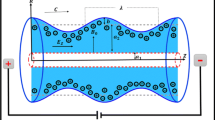Abstract
Many biosystems are complex mixtures of disparate biofluids. To study contact and transport phenomena in these mixtures, one has to apply much information on the biofluids which are components of the mixtures. A lot of the corresponding data can be extracted by means of experiments. However, it is not always easy to obtain experimental results on rather deep physical characteristics of biofluids, especially if the bioparticles are complicated systems and the fluid coexists in the mixture with a large number of other fluids. In these cases, the necessary data can, in principle, be extracted from those results which are easier to obtain experimentally. The present work proposes a method to evaluate the biofluid equilibrium pressure and electrochemical potential from common experimental values of the fluid concentration and absolute temperature as well as the fluid-particle mass, volume and spin. In so doing, the nonzero values of the particle volume are accounted for. The procedure is illustrated with a numerical example on the fluid of red blood cells (or erythrocytes) in human blood. The pressure values obtained are 49.1 and 38.8 micropascals for men and women respectively whereas the electrochemical-potential values are −2.124 and −2.130 electronvolts for men and women respectively.
Similar content being viewed by others
REFERENCES
Anderson, R. L. (1960). Germanium-gallium arsenide heterojunctions. IBM Journal of Research and Development 4: 283–287.
Bialynicki-Birula, I., M. Cieplak and J. Kaminski (1992). Theory of Quanta. Oxford University Press, New York.
Bitbol, M. (1986). Red blood cell orientation in orbit C = 0. Biophysical Journal 49: 1055–1068.
Bogolubov, N. N. and N. N. Bogolubov, Jr. (1994). An Introduction to Quantum Statistical Mechanics. Gordon and Breach, Lausanne.
Daune, M. (1999). Molecular Biophysics: Structures in Motion. Oxford University Press, Oxford.
Fung, Y. C. (1981). Biomechanics: Mechanical Properties of Living Tissues. Springer-Verlag, New York.
Eisenberg, B. (1998). Ionic channels in biological membranes: Natural nanotubes. Accounts of Chemical Research 31: 117–123.
Goth, G. (2001). The Magnitudes of Physics. http://www.smccd.net/accounts/goth/MainPages/magphys.htm
Honerkamp, J. (1998). Statistical Physics: An Advanced Approach with Applications. Springer, Berlin.
Isoda, S., S. Ueyama, H. Kawakubo, Y. Hanazato and M. Maeda (1989). Molecular electronic device based on biological electron transport system-Photoelectric properties of molecular heterojunction using flavin-porphyrin LB multilayers. In: Proceedings of the 11th Annual International Conference of the IEEE Engineering in Medicine and Biology Society 4: 1308–1309. IEEE, New York.
Israelachvili, J. N. (1992). Intermolecular and Surface Forces. Academic Press, London.
Kawakubo, H., S. Isoda, K. Inatomi, Y. Hanazato, S. Ueyama and M. Maeada (1990). Molecular orientation and photoelectric properties of molecular heterojunction using flavin-cytochrome c multilayers. In: Proceedings of the 12th Annual Internatational Conference of the IEEE Engineering in Medicine and Biology Society: 1754–1755. IEEE, New York.
Kimball, J. W. (2002). Blood. http://www.ultranet.com/~jkimball/BiologyPages/B/Blood.html
Landau L. D. and E. M. Lifshitz (1980). Statistical Physics, Part 1. Pergamon Press, Oxford.
Mamontov, Y. V. and M. Willander (2001). High-Dimensional Nonlinear Diffusion Stochastic Processes. Modelling for Engineering Applications. World Scientific, Singapore.
Mamontov, E., M. Willander and J. Weiland (2002). Stochastic continuum mechanics-A thermodynamic-limit-free alternative to statistical mechanics: Equilibrium of isothermal ideal isotropic uniform fluid. Mathematical and Computer Modelling 36: 889–907.
Marshak, A. H. and C. M. Van Vliet (1984). Electrical current and carrier density in degenerate materials with nonuniform band structure, Proceedings of the IEEE 72: 148–164.
Reichl, L. E. (1998). A Modern Course in Statistical Physics. John Wiley & Sons, New York.
Skalak, R. and Cheng Zhu (1990). Rheological aspects of red blood cells aggregation, Biorheology 27: 309–325.
Sybesma, C. (1989). Biophysics: An Introduction. Kluwer, Dordrecht.
Takeuchi, T., T. Mizuno, T. Higashi, A. Yamagushi and M. Date (1994). High field magnetic orientation of red blood cells. Physica B 201: 601–605.
Wiegräbe, W., H. F. Knapp, H. Eberhart, R. Gatz, T. Hartmann, M. Heim, Ch. Lorek and R. Guckenberger (1995). A multifunctional scanning force microscope for biological applications. Review of Scientific Instruments 66: 4124–4129.
Author information
Authors and Affiliations
Rights and permissions
About this article
Cite this article
Mamontov, E., Willander, M. Electrochemical Potentials and Pressures of Biofluids from Common Experimental Data. Acta Biotheor 51, 173–180 (2003). https://doi.org/10.1023/A:1025190005383
Issue Date:
DOI: https://doi.org/10.1023/A:1025190005383



